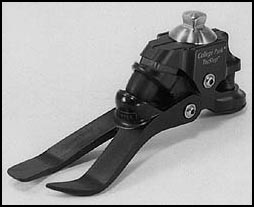

Single axis foot
Two bumpers limit and control ankle dorsi- and plantar flexion. The PF bumper permits the foot to contact the floor more rapidly during loading response than the SACH foot. The more rapid "foot flat" allows the ground reaction force line to move anteriorly, so that it falls in front of the knee and promotes early knee extension and stance stability. However, the single-axis foot is heavier than the SACH, offers no more lateral movement, and requires more frequent maintenance because dirt can foul the bumper mechanisms.

SAFE foot
SAFE is an acronym for "stationary attachment flexible endoskeletal," a foot whose arrangement of several flexible, internal keels permits triplanar movement and an easy "rollover." Nevertheless, the foot is stiff and stable during stance, and is a good choice for older people because of its light weight.

Multiaxial foot
Because the multiaxial foot permits movement in three planes, it accommodates uneven terrain and absorbs torques which would otherwise produce shearing forces on the residual limb. Its moving parts are heavy and require maintenance. Various companies, including Endolite , Otto Bock, and Ohio Willow Wood, manufacture multiaxial feet.

Dynamic response feet
This is one of many examples of dynamic response feet, which are indicated for people whose gait patterns generate enough energy to be worth storing. For this reason, some prosthetists call them "energy storing feet." They incorporate elastic keel structures that absorb energy during midstance and terminal stance, and then "release" it during preswing and initial swing. Many types are available, including the College Park Foot (pictured here), the Otto Bock Dynamic Foot, the Flex Foot, the Seattle Foot, the Quantum Foot, and the Carbon Copy II. The durability of some new materials is not fully tested.
For an excellent summary of dynamic response feet, see Edelstein, J.E. (1988). Prosthetic feet: State of the art. Physical Therapy, 68, 1874-1881.
more information on prosthetic feet: Muilenburg, A.L.,& Wilson, A.W. (1996). A Manual for Above-Knee Amputees. Ankle-Foot Systems. [On-line]. Available:
http://www.oandp.com/manuals/ak10.htm

SAFE foot
SAFE is an acronym for "stationary attachment flexible endoskeletal," a foot whose arrangement of several flexible, internal keels permits triplanar movement and an easy "rollover." Nevertheless, the foot is stiff and stable during stance, and is a good choice for older people because of its light weight.

Multiaxial foot
Because the multiaxial foot permits movement in three planes, it accommodates uneven terrain and absorbs torques which would otherwise produce shearing forces on the residual limb. Its moving parts are heavy and require maintenance. Various companies, including Endolite , Otto Bock, and Ohio Willow Wood, manufacture multiaxial feet.

Dynamic response feet
This is one of many examples of dynamic response feet, which are indicated for people whose gait patterns generate enough energy to be worth storing. For this reason, some prosthetists call them "energy storing feet." They incorporate elastic keel structures that absorb energy during midstance and terminal stance, and then "release" it during preswing and initial swing. Many types are available, including the College Park Foot (pictured here), the Otto Bock Dynamic Foot, the Flex Foot, the Seattle Foot, the Quantum Foot, and the Carbon Copy II. The durability of some new materials is not fully tested.
For an excellent summary of dynamic response feet, see Edelstein, J.E. (1988). Prosthetic feet: State of the art. Physical Therapy, 68, 1874-1881.
more information on prosthetic feet: Muilenburg, A.L.,& Wilson, A.W. (1996). A Manual for Above-Knee Amputees. Ankle-Foot Systems. [On-line]. Available:
http://www.oandp.com/manuals/ak10.htm

Multiaxial foot
Because the multiaxial foot permits movement in three planes, it accommodates uneven terrain and absorbs torques which would otherwise produce shearing forces on the residual limb. Its moving parts are heavy and require maintenance. Various companies, including Endolite , Otto Bock, and Ohio Willow Wood, manufacture multiaxial feet.

Dynamic response feet
This is one of many examples of dynamic response feet, which are indicated for people whose gait patterns generate enough energy to be worth storing. For this reason, some prosthetists call them "energy storing feet." They incorporate elastic keel structures that absorb energy during midstance and terminal stance, and then "release" it during preswing and initial swing. Many types are available, including the College Park Foot (pictured here), the Otto Bock Dynamic Foot, the Flex Foot, the Seattle Foot, the Quantum Foot, and the Carbon Copy II. The durability of some new materials is not fully tested.
For an excellent summary of dynamic response feet, see Edelstein, J.E. (1988). Prosthetic feet: State of the art. Physical Therapy, 68, 1874-1881.
more information on prosthetic feet: Muilenburg, A.L.,& Wilson, A.W. (1996). A Manual for Above-Knee Amputees. Ankle-Foot Systems. [On-line]. Available:
http://www.oandp.com/manuals/ak10.htm

Dynamic response feet
This is one of many examples of dynamic response feet, which are indicated for people whose gait patterns generate enough energy to be worth storing. For this reason, some prosthetists call them "energy storing feet." They incorporate elastic keel structures that absorb energy during midstance and terminal stance, and then "release" it during preswing and initial swing. Many types are available, including the College Park Foot (pictured here), the Otto Bock Dynamic Foot, the Flex Foot, the Seattle Foot, the Quantum Foot, and the Carbon Copy II. The durability of some new materials is not fully tested.
For an excellent summary of dynamic response feet, see Edelstein, J.E. (1988). Prosthetic feet: State of the art. Physical Therapy, 68, 1874-1881.
more information on prosthetic feet: Muilenburg, A.L.,& Wilson, A.W. (1996). A Manual for Above-Knee Amputees. Ankle-Foot Systems. [On-line]. Available:
http://www.oandp.com/manuals/ak10.htm
For an excellent summary of dynamic response feet, see Edelstein, J.E. (1988). Prosthetic feet: State of the art. Physical Therapy, 68, 1874-1881.